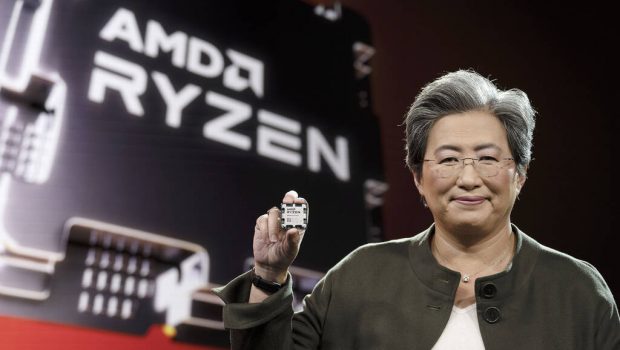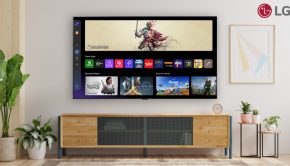AMD Introduces the fastest gaming architecture ever, “Zen 4,” with the Ryzen 7000 Series Desktop Processors
Today, AMD (NASDAQ: AMD) revealed the Ryzen™ 7000 Series Desktop processor lineup powered by the new “Zen 4” architecture, ushering in the next era of high performance for gamers, enthusiasts, and content creators. Featuring up to 16 cores, 32 threads and built on an optimized, high-performance, TSMC 5nm process node, the Ryzen 7000 Series processors deliver dominant performance and leadership energy efficiency. Compared to the previous generation, AMD Ryzen 7950X processor enables single-core performance improvement of up to +29%2, up to 45% more compute for content creators in POV Ray3, up to 15% faster gaming performance in select titles4, and up to 27% better performance-per-watt5. AMD’s most expansive desktop platform to date, the new Socket AM5 platform is designed for longevity with support through 2025.
“The AMD Ryzen 7000 Series brings leadership gaming performance, extraordinary power for content creation, and advanced scalability with the new AMD Socket AM5,” Saeid Moshkelani, senior vice president and general manager, Client business unit, AMD. “With the next generation Ryzen 7000 Series Desktop processors, we are proud to uphold our promise of leadership and continuous innovation, delivering the ultimate PC experience for gamers and creators alike.”
AMD Ryzen 7000 Series Desktop Processors
The AMD Ryzen 7000 Series once again delivers a double-digit IPC uplift over “Zen 3”6, further solidifying a track record of innovation, execution, and delivery of the award-winning “Zen” architecture. The world’s first high-performance x86 5nm CPU, the Ryzen 7000 Series ushers in the remarkable speed of “Zen 4” architecture, advancing gaming and content creation performance leadership to new levels.
At the top of the stack, the 16-core AMD Ryzen 9 7950X processor offers up to 57% better content
creation performance in V-Ray Render compared to the competition7. Meanwhile, even the 6-core AMD Ryzen 5 7600X processor offers an average of 5% faster gaming performance across select titles than the competitor’s flagship gaming processor4.
The incredible performance improvements also come with stunning advances in energy efficiency; AMD Ryzen 7950X processor is up to 47% more energy efficient than the competition8. Beyond the core, the Ryzen 7000 Series Processors feature an all-new 6nm I/O die, which enables hardware-accelerated video encode/decode9, light-duty graphics work and multi-display support. Across the CPU, a host of new power management technologies leveraged from AMD’s ultra-efficient mobile processors allow Ryzen 7000 Series Desktop processors to run more efficiently than ever before.
Ryzen 7000 Series Desktop processors are expected to be available globally from leading etailers and retailers beginning September 27, starting at an SEP of $299 USD.
| Model | Cores/Threads | Boost10/ Base Frequency |
Total Cache | PCIe® | TDP | SEP (USD) |
| AMD Ryzen 9 7950X | 16C/32T | Up to 5.7 / 4.5 GHZ | 80MB | Gen 5 | 170W | $699 |
| AMD Ryzen 9 7900X | 12C/24T | Up to 5.6 / 4.7 GHZ | 76MB | Gen 5 | 170W | $549 |
| AMD Ryzen 7 7700X | 8C/16T | Up to 5.4 / 4.5 GHZ | 40MB | Gen 5 | 105W | $399 |
| AMD Ryzen 5 7600X | 6C/12T | Up to 5.3 / 4.7 GHZ | 38MB | Gen 5 | 105W | $299 |
New AMD Socket AM5 Updates
With the introduction of the Ryzen 7000 Series Desktop processors, AMD also unveiled the new Socket AM5 platform, offering cutting-edge connectivity features like dual-channel DDR5 memory. The AM5 platform also includes up to 24 PCIe® 5.0 lanes, making it AMD’s most expansive desktop platform to date. Support for new and evolving technologies like PCIe® Gen 5 and DDR5 memory empowers users to grow with their Socket AM5 solution, which AMD will support with platform longevity through 2025 and beyond.
The new Socket AM5 motherboard family features four new chipsets, giving users the power and
flexibility to choose the exact features they want. The four chipsets feature:
- AMD X670 Extreme: Bringing the most connectivity and extreme overclocking capabilities11 with PCIe 5.0 support for graphics and storage
- AMD X670: Supporting enthusiast overclocking with PCIe® 5.0 support for storage and optional graphics support
- AMD B650E: Designed for performance users with PCIe® 5.0 storage support and optional graphics support
- AMD B650: Designed for mainstream users with support for DDR5 memory and optional PCIe® 5.0 support
New motherboards will be available starting at an SEP of $125 USD, with the AMD X670 and X670E chipsets arriving in September, and AMD B650E and B650 chipsets in October.
AMD EXPO™ Technology
New for the Ryzen 7000 Series Desktop processors and optimized for AMD Socket AM5 motherboards, AMD EXPO™ technology provides users with advanced profile settings for DDR5 memory overclocking11. When optimized for high-performance gaming, consumers can expect to see up to 11% faster gaming performance with AMD EXPO technology in F1® 202212.
AMD EXPO technology was designed to achieve higher gaming performance from pre-configured
overclocking profiles11 and is easy to implement. PC enthusiasts who want to understand the finer details of an AMD EXPO technology-enabled module can find public self-certification reports, which clearly lay out the module’s full timing table, components, and the system configuration used to finalize the memory’s specifications. AMD is offering EXPO technology to its industry memory partners without royalties or licensing fees.
AMD EXPO technology arrives to market alongside the AMD Ryzen 7000 Series processors, with
offerings from ADATA, Corsair, GeIL, G.SKILL, and Kingston. Over 15 AMD EXPO technology-enabled memory kits will be initially available, with memory speeds up to DDR5-6400.







